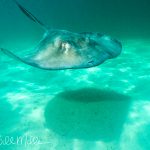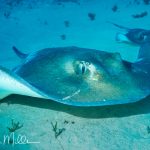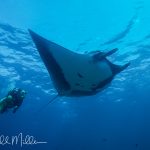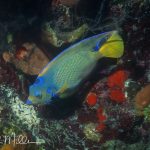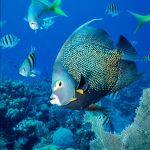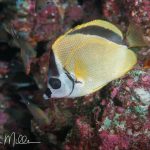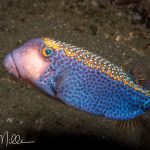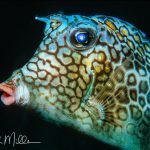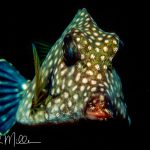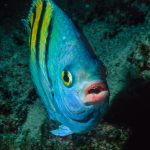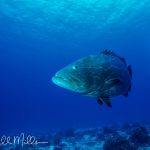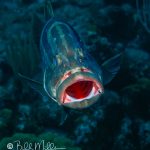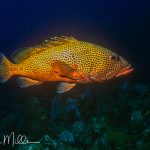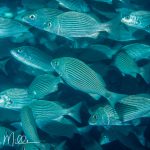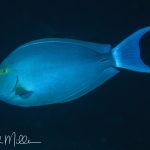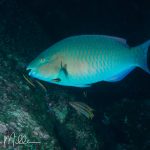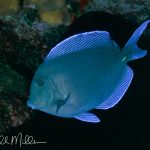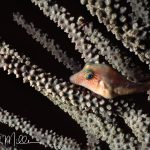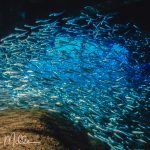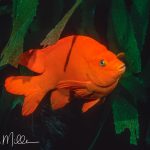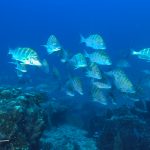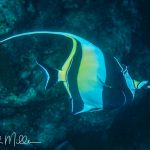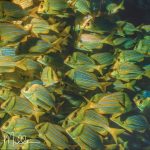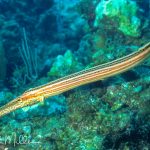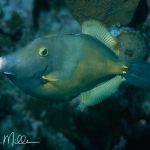There are over 20,000 fish species in the planet’s oceans, and you will only see a small sample here, less than ⅓ of 1%. Some are common, ones we have seen almost everywhere; some are fairly unique to a certain location. The Queen Triggerfish was one of the first underwater images I took in 1983 and the Black Triggerfish (aka Black Durgon) was one of the last from 2001.
>Return to Our World Underwater

Whale Shark
The captain of our dive boat got a radio message about a whale shark being in the bay. He searched and finally find it. We were free to jump in, but only with snorkeling equipment and cameras. This beauty, perhaps 25-30' long, was slowing swimming about six feet under the surface. She was filter-feeding, presenting no danger to people in the water. La Paz Bay, Baja California Sur, Mexico (1999).

Nurse Shark
Nurse sharks are commonly found laying on the bottom. They usually present little danger unless they are harassed. Little Cayman Island (1994).

Roughtail Stringray and Yellow Snappers — Photo by Sandy Miller
Sometimes you have to put the camera down and just experience it. Grand Cayman (1990)

Spotted Eagle Ray
In almost twenty years of diving, spotting an eagle ray was a rarity. In every case, they were always swimming away, and we were not chasing them! Little Cayman (1994)
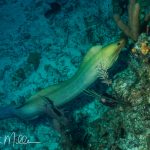
Green Moray Eel on a Night Dive
Eels usually hide in the coral during the day, but at night they come out to search for food. Belize (1998)

Frogfish
Being scaleless and unprotected, camouflage is an important defense against predators. Bonaire Island (1990)
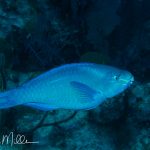
Blue Parrotfish
Parrotfish are the "sand-making" fish. They gnaw on coral for food, and, well . . . what's left over is expelled as sand. Turks and Caicos (2001)

Rockfish (?)
Cozumel, Mexico (1988). I left the "backscatter" (circular artifacts on an image, due to the camera's strobe being reflected from unfocused particulate matter in the water). Backscatter is easy, although tedious, to remove using post-processing software.

Barracuda Carefully Watching Sandy
Barracudas look threatening with a mouth full of sharp teeth, but they have always kept their distance. You move a little closer for a photo, and they back up a little bit. Barracudas are challenging to photograph with a strobe because they are highly reflective. Belize (1998)
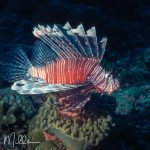
Lionfish
Lionfish can be dangerous to humans due to their venomous spines, which can deliver painful stings. While stings are usually not fatal, they can cause severe pain, swelling, and other unpleasant symptoms. Like many potentially dangerous animals, they are not aggressive, and would prefer to mind their own business. Palau (1996)
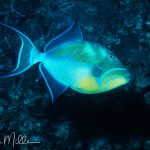
Queen Triggerfish
One of the first underwater photos I took of a very photogenic fish. Akumal, Mexico (1983).
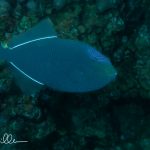
Black Triggerfish, or Black Durgon
Another Triggerfish, this photo is one of the last underwater shots I took, about eighteen years later than the first. Turks and Caicos (2001).

Scorpionfish
Scorpion fish are members of the same "family" as lionfish. These fish have excellent camouflage, and usually go unnoticed . The fins of these prickly fish carry toxic venom. While stings can be fatal to humans, the fish are not aggressive and only sting when threatened or injured. Sea of Cortez, Baja California Sur, Mexico (1999)


